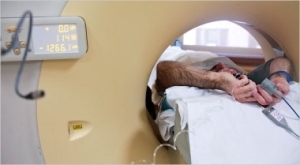No childhood cancer risk found from prenatal CT
by
Brendon Nafziger, DOTmed News Associate Editor | September 09, 2010

Good to go.
A study found no link between exposure to CT scans and other radiological imaging tests in the womb and increased risk of childhood cancers, but researchers warn they can't rule out a connection.
Earlier studies and meta-analyses suggested a slightly elevated risk from prenatal radiological exposure, especially for leukemia.
The current study was helped by Canada's universal health care, as it relied on meticulously kept Canadian databases, enabling researchers to link up radiological exams with records from a province-wide tumor registry.
In the study, published online Wednesday in PLoS Medicine, researchers looked at all 1.8 million mother-child pairs in the Canadian province of Ontario between 1991 and 2008. The group found the rate of advanced imaging tests increased almost six-fold during this study period, jumping from one out of 1,000 pregnancies to about six out of 1,000, with the vast majority of tests CT scans.
After following up with children for a median of around nine years after radiological exposure, the group found a rate of 1.13 childhood cancers per 10,000 person-years in the exposed group and 1.56 per 10,000 person-years in the group of children unexposed to the scans. But after controlling for factors like mother's age and income, the risk was about the same.
"Although major radiodiagnostic testing is now performed in about one in 160 pregnancies in Ontario, the absolute annual risk of childhood malignancy following exposure in utero remains about one in 10,000," or about 0.07 percent, the authors, led by Joel G. Ray, with the department of medicine at St. Michael's Hospital in Toronto, concluded in the report.
However, because of statistical limitations of the study - namely, the cancers are so rare that huge numbers of patients are needed to fully power the study - the authors can't completely rule out the risk from the procedure. The confidence intervals were wide, suggesting the risk ranges from only a quarter to nearly double that of the unexposed group.
"The ongoing controversy about cancer risk following prenatal exposure to radiodiagnostic imaging has not been solved," cautioned Eduardo Franco and Guy-Anne Turgeon, with McGill University in Montreal, in an accompanying editorial, "but there seems to be a general consensus that diagnostic imaging poses a high risk of inducing childhood malignancies and that the null results must be interpreted carefully."
Previous group-wide studies and meta-analyses had found slightly elevated rates of leukemia and weaker effects for solid tumors. But these studies have been dogged by controversy. Much of the knowledge of the ill effects of radiation comes from studying Japanese survivors of the atomic bombs. But even here, of the 800 survivors who received prenatal radiation exposure, only two cancer cases emerged, even though 5-14 extra cases were predicted, Franco and Turgeon note.
